JOHN COLTRANE / “Dear Lord”
Excuse me, I want to step outside a minute, way out, out into the gone-a-sphere where only angels sing; and once way out there, I want to go inside that outside, into the inner sanctum of the creator’s breath. I want to go where Trane takes you, that is, if your ears are tuned to the higher frequencies found at both extremes of his horn, but especially at the bottom when he hits those notes that fill you with the wonder of creation and remind you that a good life is a life lived to the benefit of all other life.
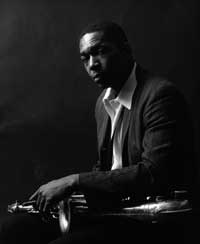 Trane, the fiercest tenor, was also the most tender. No one could caress the soul and invoke spirituality the way Trane could. For most cats, the only tender they could articulate was love for their lady. Trane was a master of romantic love ballads, but he also had two or three other gears, intense insights into emotional spiritual pools whose sublime wetness most of us seldom know.
These selections are messages from the spirit world and are available on the compilation album The Gentle Side of John Coltrane. I've noted which albums the songs were originally on for those who would like to know the context within which the individual selections were recorded.
Trane, the fiercest tenor, was also the most tender. No one could caress the soul and invoke spirituality the way Trane could. For most cats, the only tender they could articulate was love for their lady. Trane was a master of romantic love ballads, but he also had two or three other gears, intense insights into emotional spiritual pools whose sublime wetness most of us seldom know.
These selections are messages from the spirit world and are available on the compilation album The Gentle Side of John Coltrane. I've noted which albums the songs were originally on for those who would like to know the context within which the individual selections were recorded.
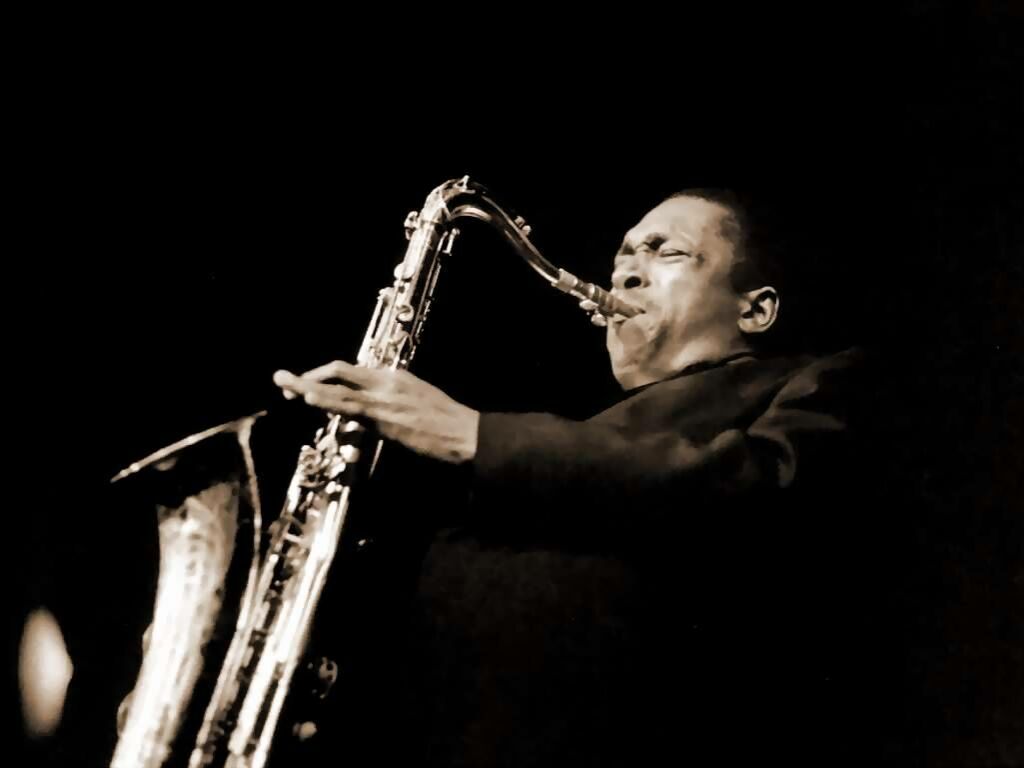 Start with “After The Rain” (originally on Impressions). This rendition makes you want to be dramatic and go outside in the rain, to taste that silvery sweetness of streets gleaming and shimmering after a soft night downpour, to smell that freshly-cleansed air, the crisp coolness of post-sundown summer temperatures reduced to comfortable. The theme seems to yearn for upward motion even as it ends on low notes. This is the feeling of the joy we get when we cast off impurities, cease bad behavior, unburden ourselves by rectifying a mistake or atoning for a sin. The absolute feeling of peace when we have made all our amends and successfully completed all our obligations. That moment when we are absolutely as good as we will ever be. Listen how Trane’s last note is no horn sound per se but that of his breath blown gently through his horn.
Start with “After The Rain” (originally on Impressions). This rendition makes you want to be dramatic and go outside in the rain, to taste that silvery sweetness of streets gleaming and shimmering after a soft night downpour, to smell that freshly-cleansed air, the crisp coolness of post-sundown summer temperatures reduced to comfortable. The theme seems to yearn for upward motion even as it ends on low notes. This is the feeling of the joy we get when we cast off impurities, cease bad behavior, unburden ourselves by rectifying a mistake or atoning for a sin. The absolute feeling of peace when we have made all our amends and successfully completed all our obligations. That moment when we are absolutely as good as we will ever be. Listen how Trane’s last note is no horn sound per se but that of his breath blown gently through his horn.
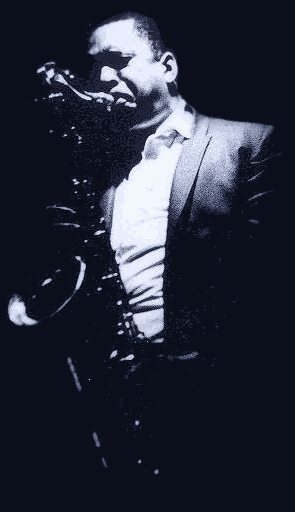 From worldly gentleness to profound sadness, i.e. an almost (but not quite) bitter resignation. Or perhaps more precisely, a recognition of rather than a resignation to the evil that men do, one unto another. In this case, it is the four little girls bombed in a Birmingham church. Trane took a speech by Dr. King, picked up the cadences and transformed those deaths and King’s sermonic declarations into one of the most moving pieces of music reflective of 20th century America. Could anyone else plummet the depths of depravity and come up with a diamond from the charcoaled embers of girl-child bones Ku Kluxed to a horrific death? In the swinging middle of the song Trane found hope, a strength to go on. Listen to how elegantly Elvin Jones drums. The third movement is back to the plangent opening sound of grief that gives way to a stirring reaffirmation of life as Trane closes with soaring and surging notes rising above Jones’ strong tom toms. “Alabama” should be required listening in every American civics class. "Alabama" was originally on Live at Birdland.
From worldly gentleness to profound sadness, i.e. an almost (but not quite) bitter resignation. Or perhaps more precisely, a recognition of rather than a resignation to the evil that men do, one unto another. In this case, it is the four little girls bombed in a Birmingham church. Trane took a speech by Dr. King, picked up the cadences and transformed those deaths and King’s sermonic declarations into one of the most moving pieces of music reflective of 20th century America. Could anyone else plummet the depths of depravity and come up with a diamond from the charcoaled embers of girl-child bones Ku Kluxed to a horrific death? In the swinging middle of the song Trane found hope, a strength to go on. Listen to how elegantly Elvin Jones drums. The third movement is back to the plangent opening sound of grief that gives way to a stirring reaffirmation of life as Trane closes with soaring and surging notes rising above Jones’ strong tom toms. “Alabama” should be required listening in every American civics class. "Alabama" was originally on Live at Birdland.
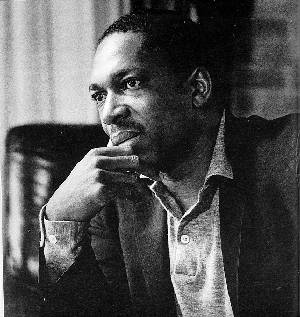 Whereas “After The Rain” was very worldly, “Welcome”—with its altissimo reaches in the opening theme—is clearly other worldly. No matter that Jones is driving on those tom toms, or that McCoy Tyner is rolling treble chords and pounding out bass clef chords, each hand a sensitive jackhammer of percussive piano technique. No matter, anchored by choice notes from bassist Jimmy Garrison, Trane is intent on suggesting we are all welcomed in the spirit world if we would but allow the music to take us there, if we would but make the commitment to reach beyond the ground we trod and tussle over as if we were mere second-graders on a schoolyard at recess. Here, Trane is trying to help us envision what can not be seen with the naked eye. "Welcome" is originally from Transition.
Whereas “After The Rain” was very worldly, “Welcome”—with its altissimo reaches in the opening theme—is clearly other worldly. No matter that Jones is driving on those tom toms, or that McCoy Tyner is rolling treble chords and pounding out bass clef chords, each hand a sensitive jackhammer of percussive piano technique. No matter, anchored by choice notes from bassist Jimmy Garrison, Trane is intent on suggesting we are all welcomed in the spirit world if we would but allow the music to take us there, if we would but make the commitment to reach beyond the ground we trod and tussle over as if we were mere second-graders on a schoolyard at recess. Here, Trane is trying to help us envision what can not be seen with the naked eye. "Welcome" is originally from Transition.
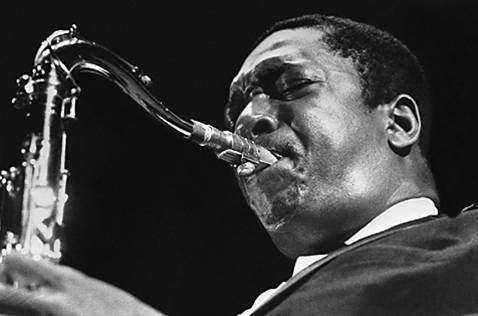 “Wise One” starts with the chimes of McCoy Tyner’s block chords and then Trane enters, starting again at the bottom of the stairs, then proceeding upward. Where “Rain” was a rolling rubato stroll with no particular rhythmic direction, “Wise One” flows into a gentle Latin-esque swing that is as delightful as warm sweet potato pie topped with thick, hand-whipped cream. This one is a man dancing magnificent leaps, executing daring triple turns and graceful twists, displaying flexibility more than muscularity, although clearly one had to be strong to make these moves. Ah, John Coltrane. Especially “aaaahhhhhh” when he builds to that series of two-note phrases that offers special insight into the dialectical nature of life. That riff starts at the 6:36 mark and releases at 6:55 into a loose restatement of the theme, before descending back into a meditative posture. "Wise One" is originally on Crescent.
“Wise One” starts with the chimes of McCoy Tyner’s block chords and then Trane enters, starting again at the bottom of the stairs, then proceeding upward. Where “Rain” was a rolling rubato stroll with no particular rhythmic direction, “Wise One” flows into a gentle Latin-esque swing that is as delightful as warm sweet potato pie topped with thick, hand-whipped cream. This one is a man dancing magnificent leaps, executing daring triple turns and graceful twists, displaying flexibility more than muscularity, although clearly one had to be strong to make these moves. Ah, John Coltrane. Especially “aaaahhhhhh” when he builds to that series of two-note phrases that offers special insight into the dialectical nature of life. That riff starts at the 6:36 mark and releases at 6:55 into a loose restatement of the theme, before descending back into a meditative posture. "Wise One" is originally on Crescent.
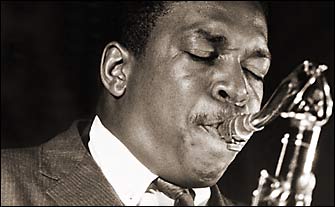 “Dear Lord,” from the album Transition, is my personal preference for no other reason than it just resonates with my flesh, my bone marrow, the dreams I have as I stand in a doorway some early mornings contemplating how the world could be if it were better and more beautiful than it is now. So, yes "Dear Lord" is a prayer, not so much for the Lord to make this world and my existence better, more beautiful, but instead a self-directed plea for me to be the better and more beautiful I long for. My prayer to be/come whatever I seek. This one also has a gentle swing, its own dance, but this time, it’s movement toward enjoining the world rather than a solo display.
OK, I’m back. Trane was such a beautiful trip. This cosmo-gram of possible human development was brought to you by STT Unlimited (Sonic Trance Transportation Unlimited), John "Onedaruth" Coltrane, conductor.
—Kalamu ya Salaam
Thank you, thank you, thank you!
See, Baba, this is where you and I overlap perfectly. I like 'Trane's Atlantic/early-Impulse stuff (and Blue Train too), but by the later Impulse period (which you like a lot), he'd left me far behind. These tunes though, are as beautiful as can be.
It's early Friday morning here in San Diego—sunlight is streaming through the sliding glass door that overlooks the canyon. Other than the sounds of 'Trane, it's quiet. Between songs, the only sound are birds chirping outside and the muted hum of my computer's harddrive. These tunes are tailor-made for times like these.
I know there's this image (mostly false) of 'Trane as a fire-breathing, waaaaay-out-there, screeching maniac. Hopefully, tunes like these—and other 'Trane tunes we've posted, like "Lush Life," which we did a few weeks ago—will help to round out people's impressions of who 'Trane is. 'Trane really could play everything from ballads to blues. He could be way out, true, but he could also play as deeply pretty as you'd ever want to hear.
As for these tunes, I already had "Alabama," "Wise One," and "After The Rain," but I'd never heard "Dear Lord" or "Welcome." So Baba, what can I say other than thank you, thank you, thank you!
—Mtume ya Salaam
He didn't just blow, he also wrote
Mtume, one other aspect to emphasize. Trane was the last great composer of modern jazz, before him you had Monk and Ellington, and to a lesser extent, Jelly Roll. By 'great composers in jazz,' I mean people whose work is often recorded by others, both in the era within which they were written as well as in at least two generations after. Secondly, I am referring to a body of work that meets the first criterion and is also deeper than three or four compositions. A Horace Silver or a Herbie Hancock are obviously both important composers and you could even argue that people often record Herbie's tunes (or Wayne Shorter's tunes), but here is where the third criterion comes in, namely, that the songs mark a major progression in the tradition of the music.
In that light, using the three criteria briefly outlined above, perhaps you can appreciate my position that Coltrane is important not only as an instrumentalist but also as a composer.
Mtume, you really ought to get The Gentle Side of John Coltrane. It's equally important as the Trane & Johnny Hartman album in terms of a full appreciation of John William Coltrane, aka "Onedaruth" (Onedaruth is John Coltrane's spiritual name).
—Kalamu ya Salaam
I forgot to mention
One other quick note that I forgot to mention. When you said, "For most cats, the only tender they could articulate was love for their lady," I really think you hit on something. That really is an element of 'Trane's playing and composing that separates him from not only other jazz musicians, but other musicians, period. He was consistently able to express the most intense, serious and meaningful ideas and themes without necessarily being aggressive or 'argumentative' about it. It's a highly unusual quality for a musical artist to have—particularly a male artist. I can only think of a few other musicians (for example, Gil Scott-Heron and Jimi Hendrix) who were able to do this consistently.
—Mtume ya Salaam
“Dear Lord,” from the album Transition, is my personal preference for no other reason than it just resonates with my flesh, my bone marrow, the dreams I have as I stand in a doorway some early mornings contemplating how the world could be if it were better and more beautiful than it is now. So, yes "Dear Lord" is a prayer, not so much for the Lord to make this world and my existence better, more beautiful, but instead a self-directed plea for me to be the better and more beautiful I long for. My prayer to be/come whatever I seek. This one also has a gentle swing, its own dance, but this time, it’s movement toward enjoining the world rather than a solo display.
OK, I’m back. Trane was such a beautiful trip. This cosmo-gram of possible human development was brought to you by STT Unlimited (Sonic Trance Transportation Unlimited), John "Onedaruth" Coltrane, conductor.
—Kalamu ya Salaam
Thank you, thank you, thank you!
See, Baba, this is where you and I overlap perfectly. I like 'Trane's Atlantic/early-Impulse stuff (and Blue Train too), but by the later Impulse period (which you like a lot), he'd left me far behind. These tunes though, are as beautiful as can be.
It's early Friday morning here in San Diego—sunlight is streaming through the sliding glass door that overlooks the canyon. Other than the sounds of 'Trane, it's quiet. Between songs, the only sound are birds chirping outside and the muted hum of my computer's harddrive. These tunes are tailor-made for times like these.
I know there's this image (mostly false) of 'Trane as a fire-breathing, waaaaay-out-there, screeching maniac. Hopefully, tunes like these—and other 'Trane tunes we've posted, like "Lush Life," which we did a few weeks ago—will help to round out people's impressions of who 'Trane is. 'Trane really could play everything from ballads to blues. He could be way out, true, but he could also play as deeply pretty as you'd ever want to hear.
As for these tunes, I already had "Alabama," "Wise One," and "After The Rain," but I'd never heard "Dear Lord" or "Welcome." So Baba, what can I say other than thank you, thank you, thank you!
—Mtume ya Salaam
He didn't just blow, he also wrote
Mtume, one other aspect to emphasize. Trane was the last great composer of modern jazz, before him you had Monk and Ellington, and to a lesser extent, Jelly Roll. By 'great composers in jazz,' I mean people whose work is often recorded by others, both in the era within which they were written as well as in at least two generations after. Secondly, I am referring to a body of work that meets the first criterion and is also deeper than three or four compositions. A Horace Silver or a Herbie Hancock are obviously both important composers and you could even argue that people often record Herbie's tunes (or Wayne Shorter's tunes), but here is where the third criterion comes in, namely, that the songs mark a major progression in the tradition of the music.
In that light, using the three criteria briefly outlined above, perhaps you can appreciate my position that Coltrane is important not only as an instrumentalist but also as a composer.
Mtume, you really ought to get The Gentle Side of John Coltrane. It's equally important as the Trane & Johnny Hartman album in terms of a full appreciation of John William Coltrane, aka "Onedaruth" (Onedaruth is John Coltrane's spiritual name).
—Kalamu ya Salaam
I forgot to mention
One other quick note that I forgot to mention. When you said, "For most cats, the only tender they could articulate was love for their lady," I really think you hit on something. That really is an element of 'Trane's playing and composing that separates him from not only other jazz musicians, but other musicians, period. He was consistently able to express the most intense, serious and meaningful ideas and themes without necessarily being aggressive or 'argumentative' about it. It's a highly unusual quality for a musical artist to have—particularly a male artist. I can only think of a few other musicians (for example, Gil Scott-Heron and Jimi Hendrix) who were able to do this consistently.
—Mtume ya Salaam
This entry was posted on Sunday, August 6th, 2006 at 12:29 am and is filed under Classic. You can follow any responses to this entry through the RSS 2.0 feed. You can leave a response, or trackback from your own site.
6 Responses to “JOHN COLTRANE / “Dear Lord””
August 6th, 2006 at 1:14 am
“The Gentle Side of John Coltrane” is an EXCELLENT collection. Thank you! In my opinion, this album sounds good, perhaps best, on one of those old all-in-one record players with speakers!
Chris
August 9th, 2006 at 4:31 am
I am reading your post, Cyber-Baba, with tears in my eyes. Coltrane is a Holy Book. Thanks for your whispered sermon.
one love,
Ekere
August 9th, 2006 at 4:39 am
“He was consistently able to express the most intense, serious and meaningful ideas and themes without necessarily being aggressive or ‘argumentative’ about it. It’s a highly unusual quality for a musical artist to have—particularly a male artist.”
Preach, Mtume!!!!! This is so true.
What I love is that the two of you are able to put language to this beauty.
one love,
Ekere
August 9th, 2006 at 12:48 pm
With an artist like Trane context is everything. If one were to experience art solely through the keyboard of some writers it would seems as though music were the invention of the human brain. Fortunately a significant amount of music lovers do not share that left-sided perspective. The fact is that in some indigenous cultures there are two terms for musicians: one term signifies a person who judiciously commands the power inherent in music and is thus sensitive to the needs of people. The other term is used to identify those who were “formally educated” to be musicians. One’s personal definition or utilization of music is nobody else’s business. But try to imagine if there were no written words to describe music, no categories or genres. What if all you had to go on was how you felt when that certain something inside you quickened at the first sensation of vibrations of sound.
Just before being found floating in New York’s East River the holy spirit or third aspect of tenor saxophone trinity (Trane being the father and Pharaoh is the son), Albert Ayler, was being pressured by Impulse to make a “hit” record. While Albert Ayler’s cause of death remains a mystery what is well documented is the disappointment and shear and utter frustration felt by the man riding the crest that demarcated the link between the supersonic otherworldliness of Trane and the gutbucket down-home blues sound of Sonny ‘Nucleus’ Rollins. An attempt at making sense of Impulse’s reasoning probably would be to consider placing Bernard Purdie’s metronomic backbeat behind Albert’s sound. On paper this executive decision sounds like crossover gold, right? If we could track the footprints dancing through the canyon of African experience in America, the full sonic spectrum of Black music enhances every nuance proceeding from volatile ethers of Albert’s saxophone bell. Quite frankly you have to love a person who brings to the bandstand the sonic equivalent of the entire Black experience from the fleeting fire and brimstone urgency of energy found mostly in sanctified churches to the rhythmically rooted and arrogant hip ness of an R&B stroll; a man who cares enough for listeners to go through the painstaking hours and hours required to develop an embouchure capable of producing a personal trademark sound filled with nuances that becomes both immediately identifiable and synonymous with the genre; a sound so pure and bright that it’s very utterance makes you immediately choose whether to embrace it or run away to safer, less urgent sounds. Albert Ayler is an enigma that straddles two worlds while, at the same time, cloaking himself in a shear veil of musical after sight known as overtones and harmonics. What you are hearing is subtleness of clusters of harmonics tightly woven together to form a tight and textured background, middle ground and foreground. This is all filtered through a cobalt blue feeling of black psycadelic illumination. Abstract images that are so basic and fundamental in the way it hits the gut it is almost scary. Not to go unnoticed are the shadow sounds; those barely audible pastel tones that are the foundation upon which the sound stands. As Albert unearths ancient artifacts and displays them in all their ritualistic context and splendor what really leaps out of the grooves of black vinyl and iridescent laser light is a stratified knowledge and a mature relationship with a greater power. Where Trane was boiling African herbs down to a potent serum and putting organic home remedies on a spoon for us, Albert was pulling roots straight out of the ground and bringing down spirits seen and unseen. However Impulse sought to sell snake oil and tried to represent Ayler as sideshow attraction. What is evident is that there are those who come along and change the way we hear music. There are those who have the means to provide us the links between what is known and accepted and what is possible; the Armstrongs, the Parkers, the Hendrix’s, the What’s Going On’s, the Kind of Blue’s, The Bitches Brew’s, the A Love Supreme’s for example. What if we could hear music, really feel music without any preconceived ideas. What would you imagine if on one humid night you were walking past someone’s bedroom window and heard both a man and a woman screaming. Could you tell right off the quality of the scream? Would you know for certain whether it was pain or pleasure? The same could be said of a scream comming from a pulpit or pews of a church congregation. I imagine a lot of the thought process would depend on whether or how one is predisposed one way or another.
John Coltrane Quartet and Johnny Hartman recording is one of the most brilliant examples of an entire ensemble of hall of fame musicians coming together where music is infinity more important than ego. The sax and vocal cosign each other with the type of single-minded duality reserved for Siamese twins and enlightened Gemini’s. Yet this is only the surface. Not very much is mentioned about the deft accompaniment of Jimmy Garrison, Elvin Jones and McCoy Tyner – three “side men” who are individually capable of stretching the aural bounds of the known universe. Together this rhythm section produces a sonic landscape so vast and panoramic that one almost takes for granted the freedom of motion available. It is the colors, textures and shading provided by the precise placement of chords and acoompaniment that set the stage for the front line. Jimmy, Elvin and McCoy lifts these standards off the page and provides a platform for Trane and Johnny Hartman to dance. There is a small but significant difference between minimalism and tastefulness. The group performs arrangements as written yet when artists of this caliber reach a level of musical and self-awareness where so much personal character comes through the performance then every single utterance is filled with purpose and intent. This is not necessarily an interpretation as much as it is submission. The choice of song(s) and knowing the intent and emotional bases is key. One ceases to listen with external ears and becomes internalized, reflective, contemplative, gone. The musicians turn themselves completely over to the music and become vehicles through which the original intent of the song is allowed to manifest unobstructed. The performance touces us in profound ways as it proceeds from a realm of selflessness. The Johnny Hartman/Coltrane Quartet recording along with Coltrane’s Ballards became, in a sense, Trane’s answer to critics who actually had the unmitigated gall to question the supersonic tenor man’s ability to play ballads. For the most part John Coltrane musical exodus from the constraints of media scrutiny was one of unparalleled growth and constant progression of ever ascending heights and delving deeper into musical expression and improvisaton. When listening to the later works of John Coltrane we notice the virtual absence of “standards”. The songs from the Gentle Side is basically preparing us for what is next. We are witnessing the progression of an artist, an art form, a man. Just check out Stellar Regions and Ogunde; two of Trane’s last recordings. This music is the state of the art of improvisation – even by todays standards.
As we can see from the selections pulled from original recording dates Trane’s original compositions were but an extention of the music that came before. The Gentle Side of John Coltrane was marketing savvy on the part of Creed Taylor’s Impulse label. Creed Taylor would later go on to start CTI which was very seminal in the distributing and marketing of Bob James, Grover Washington and others of the smooth jazz genre. How ’bout that!
August 11th, 2006 at 10:05 am
Coltrane. ColTRANE. COLTRANE. Sacred. Spirit-filled. Peace-full. Ethereal. Coltrane be puttin me there every single time.
Give thanks.
Leave a Reply
| top |